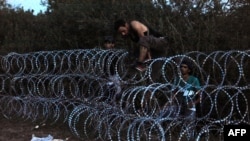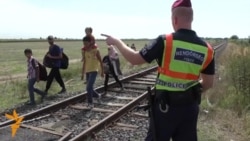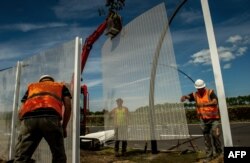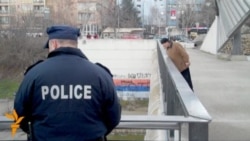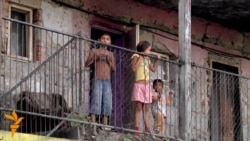The idea of erecting barriers to keep people apart did not crumble with the fall of the Berlin Wall and the collapse of the Iron Curtain.
During the last two decades, dozens of new walls and barriers have been erected around the world in response to political disputes, security concerns, or the flow of refugees and undocumented migrants.
Increasingly, new walls are being raised in Europe to try to stem the cross-border migration of refugees fleeing war zones in Africa and the Middle East or economic migrants seeking a more prosperous life in a more developed country.
New walls also have been raised as a result of security concerns and geopolitical disputes between rival neighbors.
On a smaller level, local administrators have built walls to separate impoverished districts from more affluent neighborhoods. They often justify their efforts with arguments about public health, traffic safety, and environmental concerns.
MIGRANT WALLS
While the Berlin Wall and the Iron Curtain were designed to keep citizens from leaving the Eastern Bloc, Europe's new border barriers aim to stop people from entering the West.
The structures are a response to an unprecedented flow of refugees from Africa and the Middle East trying to enter the EU's borderless Schengen Area during the summer of 2015.
WATCH: Migrant Wave Sweeps Across Hungarian Border Fence
Serbia-Hungary Border Fence
In July, Hungary's military began building a temporary razor-wire fence along its border with Serbia in an attempt to slow down an unprecedented flow of migrants and refugees trying to get into the EU from places such as Syria, Iraq, and Afghanistan.
Hungary's plans call for a 4-meter-high wall eventually to be built along the 174-kilometer stretch of border between the two countries.
By mid-August, a hastily built temporary barbed-wire fence was proving useless at stopping a surge of migrants who have followed the Balkan route from Turkey to Greece by sea, up north to Macedonia and through Serbia to reach EU-member Hungary.
Once in Hungary, many try to head further north and west to wealthier EU countries like Germany, the Netherlands, or Sweden.
Hungary's military announced that it will deploy a police force of 2,100 "border hunters" in September who will use helicopters, police dogs, and horseback patrols to guard the border fence until a more permanent border wall is built.
Bulgaria-Turkey Barbed Wire And Troops
Bulgaria began building a metal fence with barbed wire along its border with Turkey in 2014 in a bid to prevent human traffickers from smuggling in asylum-seekers.
Currently stretching across 80 kilometers, Bulgaria plans to extend the fence along the remaining 200 kilometers of its border with Turkey by the end of 2015.
The fence is 5 meters high and includes a 2-meter thick layer of barbed wire.
More importantly, Bulgaria's new border fence is monitored around the clock by 1,500 armed guards who are stationed at watchtowers and other strategic points.
Bulgaria has announced plans to deploy another 2,100 army troops to prevent asylum-seekers from crossing into the country.
Those deployments would bolster Bulgaria's border with Greece, which has been swamped with refugees arriving by sea from Turkey since Bulgaria tightened its land border with Turkey.
Channel Tunnel Security Fence At Calais
Britain's government has paid more than 9 million euros ($10 million) to install a massive new security fence around the Channel Tunnel terminal in Calais, France, during the summer of 2015.
The move came after thousands of migrants over the course of several days tried to break into the port facility and illegally enter Britain aboard the Channel Tunnel's rail links or by stowing away on trucks that make the channel crossing on ferries.
The reinforced security fence was completed at the beginning of August. Extra security patrols and dog teams also have been brought in to protect the Eurotunnel port.
But reports suggest migrants have still been able to break through the strengthened fences at Calais to reach the security zones near the Channel Tunnel terminal.
Spain's African Coast Cities
Spain built walls around its territory on the northern coast of Africa during the 1990s in an attempt to stop African migrants from entering Spanish territory.
Altogether, there are about 20 kilometers of walls around the autonomous Spanish cities of Melilla and Ceuta -- seaside exclaves that border Morocco.
Each wall is now 6 meters tall and is reinforced by infrared cameras, tear-gas canisters, noise and movement sensors, and observation towers.
U.S.-Mexico 'Secure Fence'
The United States has built several stretches of border fences and barriers since 1990 that are designed to prevent illegal immigration from Mexico, as well as drug smuggling by Latin American cartels.
President George W. Bush expanded that effort after the September 11, 2001, terrorist attacks against the United States.
The U.S. Congress in 2006 provided funding for 1,100 kilometers of border fencing and barriers under the Secure Fence Act.
Those barriers are part of three separate border operations in the states of California, Arizona, New Mexico, and Texas.
A massive border fence has been completed from San Diego, California, to Yuma, Arizona.
There also are completed sections in urban areas such as El Paso, Texas.
Plans had called for parts of the 3,100-kilometer U.S.-Mexico border to be monitored by what the Bush administration had described as a "virtual fence" -- a high-tech monitoring system employing mobile surveillance devices, sensors, and a chain of electronic monitoring towers.
But the Obama administration in 2010 halted new work on that project, diverting the funds to other purposes.
U.S. presidential hopeful Donald Trump has been campaigning to replace the border fence and monitoring stations with even taller concrete walls and other barriers to close off the entire U.S.-Mexico border.
GEOPOLITICAL WALLS
War and terrorism in the Middle East, as well as concerns about Russia's military muscle flexing along its borders with Europe, have resulted in plans for new border walls that are motivated by geopolitics and security interests.
Ukraine's Defense 'Wall' On The Border With Russia
Ukraine announced an ambitious project to seal its porous 2,000-kilometer border with Russia in March 2014 after Russian forces seized the Crimean Peninsula and annexed the region through a dubious referendum that has been internationally condemned as illegal.
Ukraine began work on the barrier in September 2014. But the project has been stalled by its $250 million price tag, which the cash-strapped government in Kyiv can ill afford.
So far, workers have dug a few hundred meters of antitank ditches along a part of the border where a metal fence with barbed wire has been erected.
Despite being called a "wall" by officials in Kyiv, the project is not intended to be a massive concrete barrier.
Rather, plans call for a sophisticated system of defense fortifications and modern electronic surveillance tools.
The practicality of the project also has been questioned by critics who note that pro-Russian separatists now control about 410 kilometers of Ukraine's eastern border with Russia, making it impossible for the government in Kyiv to stop cross-border deployments of Russian troops and combat equipment.
Despite mounting evidence, the Kremlin continues to deny that it has sent troops or military hardware into eastern Ukraine.
Estonia's Plans To Wall Off Its Border With Russia
Estonia's government in August 2015 announced plans to build a wall on its border with Russia in order to fend off what it has referred to as "Russian trespassers."
The plan calls for a 108-kilometer wall along the land section of the Russian-Estonian border that is 2.5-meters high and is reinforced with barbed wire on top.
Estonia's Border Guard Board also plans to install video cameras across the entire perimeter of the wall and deploy patrol drones to detect what it calls "Russian invaders."
With an estimated cost of 71 million euros ($81 million), construction is scheduled to begin in 2018.
The Estonian security measures are seen as a response to Russian aggression in the region -- including the September 2014 seizure of Estonian police officer Eston Kohver.
Estonian officials say that Kohver was investigating cross-border smuggling operations by a Russian criminal group and was abducted by Russian agents on the Estonian side of the border and dragged into Russian territory.
A Russian court in August 2015 sentenced Kohver to 15 years in prison.
UN-Built Kuwait-Iraq Barrier
During the 1990s, after the first Gulf War, the United Nations funded and built a security barrier along the entire Kuwait-Iraq border to prevent incursions into Kuwait by Saddam Hussein's military forces.
Stretching across 217 kilometers of desert, the UN project is similar to the fenced portions of Israel's West Bank security barrier.
It has ditches and earth berms that protect the outer fences, security patrol roads along the entire perimeter, and electrified barbed wire in the middle.
When U.S.-led forces invaded Iraq in March 2003, the first stage of the ground operation was to punch holes through the UN-built security barrier for the attacking columns to pass through.
Saudi Arabia's 'Great Wall' Against IS In Iraq
Saudi Arabia is building a 965-kilometer chain-link and barbed-wire fence along its border with Iraq, saying that the massive Northern Border Security Project is needed to protect against infiltrations by Islamic State militants.
Stretching from the town of Turaif near Jordan to Hafar al-Batin near Kuwait, the project has been dubbed a "Great Wall" by Saudi officials.
In fact, the design is similar to the Kuwait-Iraq barrier that was built by the UN during the 1990s.
Saudi Arabia's plans call for two high fences about 300 meters apart with barbed wire in the middle, about 40 watchtowers, a network of fiber-optic cables, and patrol roads for surveillance vehicles.
Sand-berm embankments on the Iraqi side of the fence would slow infiltrators and help prevent vehicles from smashing through the barriers.
Iran's Border Walls With Pakistan And Afghanistan
Iran began to build a wall on its border with Pakistan in 2007 in an area near their borders with Afghanistan known as Balochistan.
Iranian authorities say the 3-meter-high concrete and barbed-wire wall is being built to stop smuggling, drug trafficking, and illegal immigration.
But some analysts say the barrier also is aimed at preventing Islamic extremists from crossing into Iran.
Iranian state media reports have said the wall could eventually stretch along 700 kilometers of the border and that it should be completed by 2018.
In the early 1990s, Iran also began to build what authorities in Tehran called a "wall" along its lengthy eastern border with Afghanistan in order to stop drug smugglers and infiltration by armed militants.
Iranian authorities say 90 percent of that project is now complete.
Although it sometimes consists of simple fencing and barbed wire, there are about 1,000 kilometers that have been strengthened by embankments, ditches, canals, or cement walls.
Pakistan-Afghanistan Fences And Border Trenches
Pakistan, together with Afghanistan's government and the International Security Assistance Force in Afghanistan, has built a 35-kilometer portion of fence along a part of its border with Afghanistan where continuous cross-border movement by militants had been documented.
Pakistan also has dug more than 250 kilometers of a proposed 1,100-kilometer trench along the border of its southwestern province of Balochistan and Afghanistan.
The projects are part of an initiative announced in 2005 to create a 2,400-kilometer fence and security barrier along the entire Pakistan-Afghan border.
But that broader plan was discontinued after 2009 for lack of funds.
Since then, Afghanistan's Foreign Ministry has raised "grave concerns" about the project, accusing Pakistan's military of undertaking "unilateral construction and physical reinforcement activities" along the border with Afghanistan's eastern province of Nangarhar.
To date, the attempts to block the border have had little success because militants are able to simply travel around the sporadic sections of border barriers.
Retired Afghan National Army General Javed Kohistanti told RFE/RL in the spring of 2015 that there were still about 300 crossing points used regularly by militants to cross back and forth between Pakistan and Afghanistan.
Turkmenistan's Central Asian Barrier
Turkmenistan President Saparmurat Niyazov in 2001 ordered the construction of a 1,700-kilometer fence along his country's northern borders with Uzbekistan and Kazakhstan.
Niyazov said the barbed-wire border barrier was needed to prevent smuggling and illegal migration from neighboring former Soviet republics in Central Asia.
In addition, Niyazov acknowledged that the creation of a physical border fence would help Turkmenistan "avoid any future dispute" over the precise demarcation of the border.
Mitrovica's De Facto Partition Bridges In Northern Kosovo
The city of Mitrovica in northern Kosovo has been divided between Serbs on the north side of the Ibar River and ethnic Albanians to the south since a de facto partition of the city occurred at the end of the Kosovo war in June 1999.
The main bridge crossing the Ibar River was a symbol of Kosovo's division for more than a decade -- a territorial dispute in which Belgrade and Kosovar Serbs to the north of the Ibar River still refuse to recognize Pristina's 2008 unilateral declaration of independence from Serbia.
WATCH: Years After Kosovo War, Mitrovica's Divisions Hold Firm (2013)
Serb paramilitary fighters and volunteers who call themselves "bridge-watchers" erected an earth-and-stone barricade that blocked vehicles from crossing the north side of the main bridge for more than a decade.
The barricades and bridge-watchers remained on the north side of the bridge even after the French government funded the refurbishment of the main bridge and handed it over to the municipality in 2001.
Three bridges that now cross the Ibar River in Mitrovica continue to serve as military checkpoints along a de facto border between Kosovo's northern Serbian enclaves and the rest of Kosovo.
However, the earth berms were removed in 2013 when North Mitrovica officially became a separate municipality under an EU-brokered agreement following the North Kosovo crisis.
KFOR peacekeepers, police from the EU's Rule of Law Mission in Kosovo (EULEX), and Kosovar police continue to monitor traffic on the city's bridges.
Israel's 'Security Barriers'
The largest and most controversial of the newly erected walls since 1989 have been built by Israel.
The structures actually consist of a mixture of fences, barbed wire, ditches, and concrete slabs up to 8 meters in height.
Israel insists on calling the structures "security fences" and "security barriers," rejecting critics who make comparisons to the Berlin Wall and the Nazi-built Warsaw ghetto wall.
There are three.
One was built along Israel's border with the Gaza Strip.
Another was built by Israel along Egypt's border with the Gaza Strip to stop militants from sending fighters and supplies into Gaza from the Sinai Peninsula.
The third, and most controversial, divides Israel from the West Bank but also passes around Jewish settlements in occupied Palestinian territory.
Critics say that structure has derailed the Middle East peace process because it unilaterally establishes a new border and annexes 9 percent of the territory in the occupied West Bank.
Plans call for the West Bank barrier to stretch for 700 kilometers when it is completed.
About 500 kilometers have been built since the project received financing in 2000.
More than 90 percent of Israel's security barrier is made up of a multilayered series of fences -- usually three fences with stacks of barbed wire on top, along with ditches to prevent vehicles from smashing through the barrier, patrols roads on each side, and a smooth strip of sand in the middle to help track infiltrators.
Sections with concrete walls up to 8 meters high are common in urban areas such as Jerusalem and Qalqilyah and along a highway where people have been shot by Palestinian snipers.
The UN General Assembly, the International Court of Justice, and the European Union have all said that portions of the barrier erected in occupied territory violate international law.
The International Red Cross says those sections violate the Geneva Conventions and go beyond what is allowed by an occupying power.
WALLS BUILT BY LOCAL GOVERNMENTS
Local officials have often ordered the construction of walls that separate impoverished neighborhoods from other parts of the community. Justifications given by local authorities have ranged from public health and traffic-safety issues to environmental concerns.
Usti nad Labem, Czech Republic
A 2-meter-high, 65-meter-long wall was built in the Czech town of Usti nad Labem in 1999 after complaints by residents that Roma were noisy and unhygienic.
Local authorities called it a "noise barrier" and part of an urban renewal project that prevented Roma children from running into the street. Critics said it created a Roma "ghetto."
After opposition from the European Union, the Czech Republic demolished the wall on November 24, 1999.
Nevertheless, the Czech Republic's Constitutional Court ruled in 2000 that Czech lawmakers exceeded their legal powers when they ordered the demolition of the wall, saying the issue was a matter to be decided by local self-government.
WATCH: In Slovakia, Roma Grapple With Social Divisions And Real Walls (2014)
Kosice, Slovakia
In 2013, there were more than a dozen Roma walls built in Slovakia, including eight in the regions of Kosice and Presov, which have the country's highest Roma populations.
The European Commission in the summer of 2013 complained that a newly erected wall in the town of Zapad in the Kosice district was a violation of the EU's stand against racism because it segregated the Roma population at a time when Kosice was designated as a European Capital of Culture.
Ostrovany, Slovakia
A 150-meter-long, 2-meter high concrete wall was erected in October 2009 by local government in the poor rural eastern Slovakia village of Ostrovany to separate Roma from the rest of the population. The mayor argued that the goal was to "stop vandalism and theft." Two-thirds of Ostrovany's 1,800 residents are Roma.
Baia Mare, Romania
In Baia Mare, Romania, the local government erected a wall that blocked off government housing for about 1,000 Roma. The mayor, Catalin Chereches, argued that the 1.8-meter-high concrete wall was designed to "prevent traffic accidents."
But pro-democracy groups like the Center for Legal Resources called the wall an initiative that belonged to the Nazi era, arguing that "the idea to separate a community with severe social problems amounts to institutionalized racism."
Rio de Janeiro's Shantytown Walls
Rio de Janeiro began buildings concrete walls around some of its shantytowns at the start of 2009.
Administrators in the Brazilian city say the aim is to prevent the shoddily constructed and impoverished communities from expanding into the forest and destroying the vegetation of Tijuca Park, a large urban nature reserve.
But critics charge that the walls, which are as high as 3 meters, represent an attempt by local authorities to separate poor areas from richer residential neighborhoods.




